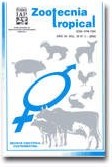
|
Zootecnia Tropical
Instituto Nacional de Investigaciones Agrícolas Venezuela
ISSN: 0798-7269
Vol. 28, No. 1, 2010, pp. 57-64
|
 Bioline Code: zt10008
Bioline Code: zt10008
Full paper language: English
Document type: Research Article
Document available free of charge
|
|
|
Zootecnia Tropical, Vol. 28, No. 1, 2010, pp. 57-64
| en |
Substitution of the traditional energy source (corn) by sugar cane molasses B in diets for finishing pigs
Almaguel, Ramiro E.; Piloto, Jorge L.; Mederos, Carmen M.; Cruz, Elizabeth & Ly, Julio
Abstract
For this study forty-four castrated males pigs of the commercial crossing YL x CC21 (1:1) with 75 days of age
and 22.0 kg live weight, were used with the aim of study animal performance of growing-fattening pigs fed with
feed B and NUPROVIM 10 in diets based in sugar cane molasses B as an energy source. The pigs were allotted at
random in blocks with three treatments. The effect of a concentrated B (balanced feed based on soybean and corn
meal and 30% of the wheat Cuban byproduct), treatment 1 and NUPROVIM 10 (N10) in diets of sugar cane B
molasses, treatment 2, was studied. Additionally, it was carry out a third treatment (control), using a concentrated
feed based on cereals and soybean meal. There were significant differences for the dry matter consumption, kg
(P < 0,05) treatment 1:2,78; treatment 2:2,61; treatment 3:2,56; daily gain, g/day (P < 0,001) 779; 807; 853 and
final weight, kg (P <0,01) 97,11; 99,83 y 102,38; respectively. These results confirmed that the use of the sugar
cane molasses in Cuba constitutes an important source of energy in the alternative feeding and that it is possible
to obtain results in the animal performance traits comparable to those reached with conventional diets based on
cereals and soybean meal.
Keywords
Growing-fattening pigs, B molasses, NUPROVIM.
|
| |
| es |
Almaguel, Ramiro E.; Piloto, Jorge L.; Mederos, Carmen M.; Cruz, Elizabeth & Ly, Julio
Resumen
Se utilizaron 54 cerdos del cruce comercial YL x CC21 machos castrados y hembras (1:1) de 75 días de edad
y peso vivo promedio de 22,0 kg con el objetivo de estudiar los rasgos de comportamiento animal de cerdos
en crecimiento-ceba alimentados con formulas de Pienso B y NUPROVIM 10 en dietas basadas en miel B de
caña de azúcar como fuente de energía. Los cerdos fueron distribuidos en un experimento diseñado en bloques
al azar en tres tratamientos. Se estudió el efecto de la utilización de un pienso B (concentrado balanceado de
mediana calidad, basado en harina de soya + maíz y un 30 % del subproducto cubano del trigo), tratamiento 1 y
del NUPROVIM 10 (N10) en dietas de miel B de caña de azúcar, tratamiento 2. Adicionalmente se utilizó un
tercer tratamiento (control), en el que se ofreció un pienso concentrado basado en cereales y harina de soya. Hubo
diferencias significativas en cuanto a consumo de materia seca, kg (P < 0,05) tratamiento 1:2,78; tratamiento
2:2,61; tratamiento 3:2,56; ganancia de peso, g/día (P < 0,001) 779; 807; 853 y peso final, kg (P <0,01) 97,11;
99,83 y 102,38 respectivamente. Estos resultados confirmaron que el uso de las mieles de caña de azúcar en Cuba,
constituye una importante fuente de energía en la alimentación alternativa y que es posible obtener resultados
en los rasgos de comportamiento animal comparables a los alcanzados con dietas convencionales basadas en
cereales y harina de soya.
Palabras-clave
Cerdos en crecimiento-ceba, miel B, NUPROVIM
|
| |
© Copyright 2010 - Zootecnia Tropical
Alternative site location: http://www.sian.inia.gob.ve/repositorio/revistas_ci/ZootecniaTropical/ztindice.htm
|
|
